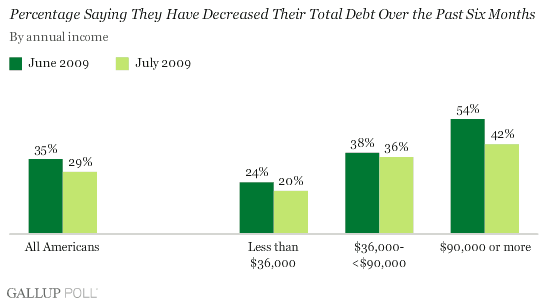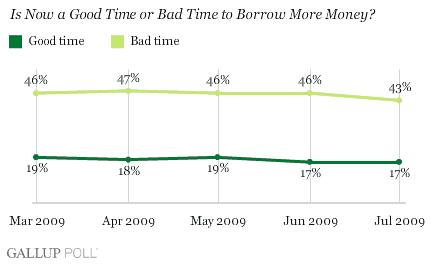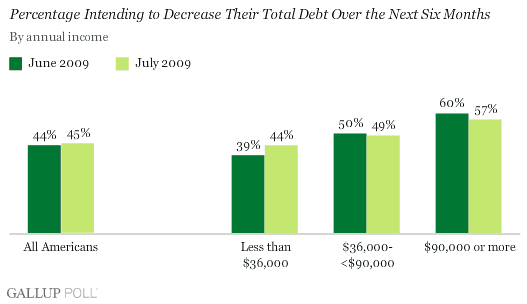PRINCETON, NJ --The Gallup Personal Credit survey for July finds 27% of all Americans saying they increased their overall debt over the past six months -- marking an increase from 22% in June and from what Gallup has measured since March. At the same time, 29% decreased their debt, compared to 35% in June and roughly one-third of consumers since March. Given the current credit environment, increased consumer credit use may be seen as at least a mild positive for future economic growth.

Fewer Upper-Income Americans Decreased Their Debt in July
Perhaps in response to the stronger equities markets, the most pronounced drop in debt reduction in July was among upper-income Americans. In June, 54% of upper-income consumers said they had decreased their overall debt over the past six months, but in July this fell to 42%.

Fewer Than One in Five Americans Say Now Is a Good Time to Borrow
Even though more Americans increased their debt in July than did so earlier in the year, only 17% concurrently said now is a "good time" to borrow money -- unchanged from June and not much different from any time since March. On the other hand, 43% think it is a "bad time" to borrow -- slightly improved from the 46% to 47% of the previous four months.

Nearly Half of Americans Intend to Decrease Their Debt Over Next Six Months
Given their continuing negative views of the credit environment, 45% of Americans say they intend to reduce their total outstanding debt over the next six months -- essentially unchanged from 44% in June. Upper-income consumers continue to be most intent on reducing their debt, although the gap across income levels decreased somewhat in July from June.

Commentary
The Federal Reserve reported Friday that consumer credit growth declined by $10.3 billion in June -- the fifth straight monthly decline in consumer credit use, which is the longest series of declines since 1991. In part, these declines may reflect the "new normal" in consumer credit use as Americans have pulled back from making purchases requiring the use of credit. At the same time, the reduced credit use during the first half of 2009 probably also reflects the tighter underwriting standards currently being applied to all forms of consumer credit.
Gallup's Personal Credit survey results for June are fully consistent with this Federal Reserve report, with 35% of consumers saying they had decreased their debt and only 22% saying they had increased it. This indicated another major drop in consumer credit use, which the Fed report confirmed.
The July results suggest that consumer credit use changed last month: the gap between those decreasing and those increasing their credit use narrowed from 13 points in June to only two points (29% decreasing debt versus 27% increasing it). In turn, these results also indicate that consumer credit use will likely rise in July -- although it will not necessarily turn positive -- when the Federal Reserve reports it at the end of this month.
The July increase in credit use may reflect the surge in the equities market since the March lows and the resulting positive "wealth effect," making many Americans feel better about their personal balance sheets and their use of credit. In addition to this positive impact on consumer psychology, it is also possible that consumer credit underwriting standards have eased somewhat, with the nation's financial institutions showing better earnings.
It is also worth noting that the "cash for clunkers" program was implemented on July 24 and that Chrysler announced matching incentives on July 22. It is possible that the initial enthusiasm for this program may have positively affected consumers' self-reported credit use in Gallup's Personal Credit survey that was conducted on July 27 -- particularly because the law authorizing the program took effect on July 1.
These new government tax incentives combined with major dealer incentives succeeded in getting consumers back into the auto showrooms in July and are likely to continue to do so now that the program has been extended. Psychologically, they provided such a good deal on a new vehicle that consumers could view these purchases as a form of saving, not spending. After 9/11, the auto companies themselves did something similar with major purchase incentives that had similar positive results both on consumer psychology and consumer auto purchases.
However, Gallup's survey results also suggest that this time around, the impact on consumer credit use and consumer buying behavior may be only a temporary phenomenon. Although slightly fewer Americans see this as a bad time to borrow, there has been no improvement in the number of consumers seeing this as a good time to do so. Nor has the percentage of Americans intending to decrease their debt going forward changed.
These findings may reflect the credit-use "new normal." There are many Americans who meet the post-financial-crisis credit standards of 2009. Given the opportunity to make a major purchase at a highly attractive price, they will use their access to credit. But as is the case with the spending "new normal," this does not necessarily mean American consumers' intentions to de-leverage and rebuild their personal balance sheets have changed. In turn, this implies that the impact of the "cash for clunkers" program on consumer credit use and the economy may provide only a temporary -- if much-needed -- boost to the auto sector and the overall U.S. economy.
Survey Methods
Gallup Poll Daily interviewing includes no fewer than 1,000 U.S. adults nationwide each day during 2008 and 2009. Gallup Personal Credit Index results for this year are based on questions asked of 1,000 or more adults conducted March 23, April 27, May 29, June 29 and July 27, 2009. For results based on these samples, the maximum margin of sampling error is ±3 percentage points.
For results prior to 2008, telephone interviews were conducted with 1,000 or more adults, aged 18 and older. For the total sample in these surveys, one can say with 95% confidence that the maximum margin of sampling error is ± 3 percentage points.
Interviews are conducted with respondents on land-line telephones (for respondents with a land-line telephone) and cellular phones (for respondents who are cell-phone only).
In addition to sampling error, question wording and practical difficulties in conducting surveys can introduce error or bias into the findings of public opinion polls.
Polls conducted entirely in one day, such as this one, are subject to additional error or bias not found in polls conducted over several days.
